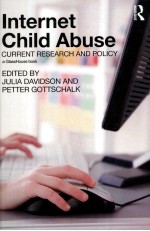

INTERNET CHILD ABUSE CURRENT RESEARCH AND POLICYPDF电子书下载
- 电子书积分:9 积分如何计算积分?
- 作 者:JULIA DAVIDSON AND PETTER GOTTSCHALK
- 出 版 社:ROUTLEDGE
- 出版年份:2011
- ISBN:0415559804
- 页数:197 页
Introduction&JULIA DAVIDSON AND PETTER GOTTSCHALK 1
Context and relevance 1
Book structure 3
Notes 6
References 6
1. Legislation and policy: protecting young people, sentencing and managing Internet sex offenders&JULIA DAVIDSON 8
Introduction: young people's online behaviour 8
Legislation: online grooming 9
Indecent images of children 12
The relationship between indecent image collection and contact offending 16
Sentencing of Internet sex offenders 17
Internet sex offenders: assessing and managing the risk - the UK example 18
The effectiveness of UK multi-agency public protection arrangements in monitoring Internet sex offenders 20
Conclusion 22
Notes 23
References 24
Legislation 26
Cases 26
2. Characteristics of the Internet and child abuse&PETTER GOTTSCHALK 27
Introduction.: understanding the Internet 27
Seventeen Internet characteristics 28
The role of web cams 35
Technology behind MySpace 35
Virtual communities 37
Understanding online groomers 42
Understanding children's online behaviour 45
Perspectives on child sexual abuse 47
Internet crime 48
Conclusion 49
Notes 49
References 49
3. Combating child abuse images on the Internet: international perspectives&JOHN CARR AND ZOE HILTON 52
Introduction and context 52
The link between possession and contact offending 53
Step change in the scale of production and distribution 54
A child's legal right to protection 55
Political initiatives at EU level and beyond 56
Report of the International Center for Missing and Exploited Children 59
Practicalities of law enforcement investigations 61
International law enforcement activity 62
New technology to support police work and help protect children 64
Disruption methods 65
Slow takedown times 65
Blocking technology - reducing the availability of child abuse images 67
Creating a unified list of websites of child abuse material 69
The Financial Coalition Against Child Pornography 70
The lack of international political mechanisms.: ICANN's role 71
Victim identification and care 71
Slow progress on victim identification despite joint working 72
Ongoing care for children 73
Conclusion 73
Notes 74
References 78
4. Stage model for online grooming offenders&PETTER GOTTSCHALK 79
Introduction 79
Stages of growth models 80
Online grooming offence 81
Stages of online offending 83
Police investigations 91
Internet red buttons 93
Sex offender progression 99
References 100
5. Understanding the perpetrators' online behaviour&ELENA MARTELLOZZO 104
Introduction 104
Background and context 104
Methodology 106
Offenders creating a profile 106
Hyper-confident groomers 107
The hyper-cautious groomer 108
Understanding online offenders 109
Case study.: an offender operationaIising a profile 110
Offender research: justifying the offence 111
Exploring discovery 112
Exploring denial 114
Denial and indecent images 116
Exploring distorted attitudes towards children 118
Exploring sex offenders' adult relationships 120
Conclusion 121
Notes 122
References 122
6. Policing social networking sites and online grooming&JON TAYLOR 126
Introduction 126
Historical context of Internet abuse and policing 126
Social networking sites 127
Policing child sexual abuse online 129
Covert police operations 131
Contact offending and non-contact offending 132
Findings: researching offender online behaviour 134
Policing contact offences and non-contact offences in the virtual world 139
Policing online child sexual abuse 143
Reactive policing of online CSA 145
Proactive policing of online CSA 145
Proactive reactive policing of online CSA 146
Conclusion 146
Notes 148
References 149
7. Assessment and treatment approaches with online sexual offenders&MATT O'BRIEN AND STEPHEN WEBSTER 153
Introduction 153
Assessing online sexual offenders: ethical challenges 154
Collaborative assessments and readiness 155
Assessment methods 157
Social history and psychological functioning 157
Indecent image content 158
Static and dynamic risk 159
Cognitive and behavioural functioning 160
Future directions 162
Treatment targets for online sexual offenders 163
Specifically tailored approaches to treatment 167
i-SOTP 167
Other emerging tailored treatment programmes 170
Other (non-group based) approaches 175
Strategies employed to address problematic Internet use 177
Conclusion 178
References 178
Conclusion&JULIA DAVIDSON AND PETTER GOTTSCHALK 186
References 188
Index 190
